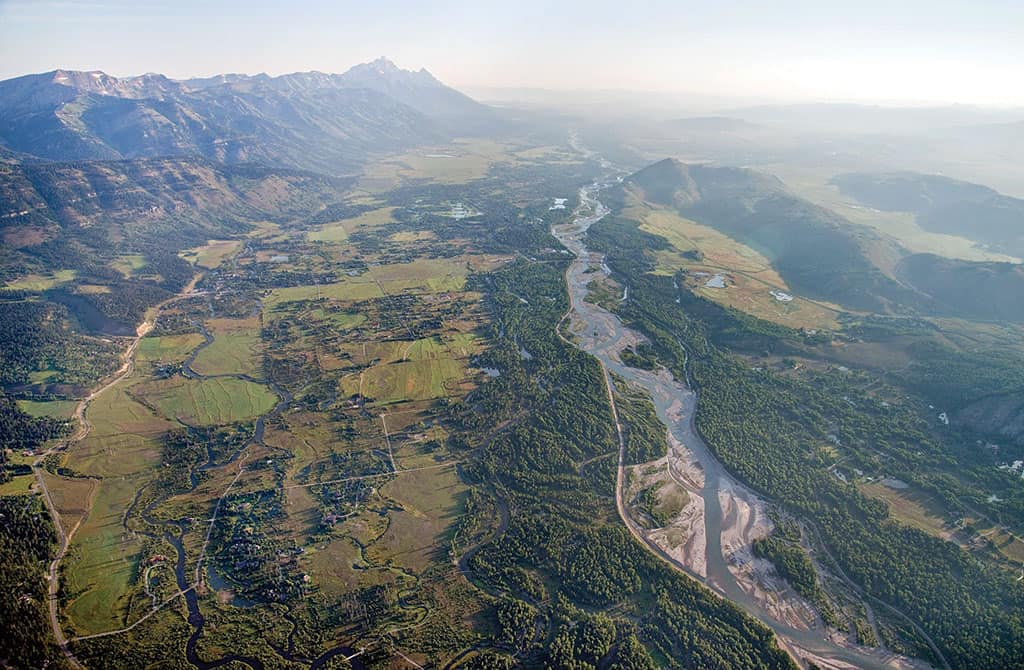Read The
Current Issue
Down By the River
This summer, a previously unregulated, popular stretch of the Snake River is coming under Teton County’s purview, and most everyone agrees it’s needed.
By Mark Huffman

ON A SUNNY summer morning, Jay Pistono was standing on the bank of the Snake River.
Directing traffic.
At the boat ramp on what’s called parcel 13, at the Highway 22 bridge over the Snake River, things were going smoothly, with no need for Pistono’s gentle herding. That’s been the norm during his six years as the Snake River Fund’s river ambassador, moving things along, answering questions, checking registration and inspection stickers, and counting boats and people.
But as Pistono talked to a Lewis & Clark Expeditions guide who was unloading a couple of rafts, he saw something he tries to prevent. People had parked a big trailer and blocked the riverbank. They slowly inflated five rafts with hand pumps. They made a big pile of life vests.
The Lewis & Clark guide had his boats in the river, his customers loaded and floating south within ten minutes. The people with the rented rafts—about fifty on a family reunion adventure—crowded the access for an hour. Luckily, timing and good manners came together. The reunion mob didn’t block anyone from the water, and no one got testy. It doesn’t always work out that way. “I’ve seen people shoving each other around,” Pistono says. “You can get a competitive atmosphere, get little altercations because people get excited.”
Rebecca Reimers, former executive director of the Snake River Fund (she stepped down last winter after nearly three years at the helm), agreed about the busy river between parcel 13 and, twelve miles downriver, the South Park Bridge, two ends of a heavily used stretch. Boating there is sometimes “like commuting,” she says. “This stretch of the river was fairly unknown, undiscovered for years. But there’s just more people there now—and there are crazy days.”
There are crazy days because it’s a beautiful run, popular with locals who float and fish it for their own pleasure and with those in the business of taking tourists on the water. A study completed by Confluence Research and Consulting in February 2014 estimated private boats from Wilson to South Park at 50 a day in 2013, sometimes 70. Commercial use is about 30 guided fishing trips daily and 70 scenic floats. Every day, 150 boats. Use has increased over the years, enough that some think it’s already too high, and most agree the increase can’t go on without some management.

THE TWENTY RIVER miles between where the Snake River leaves Grand Teton National Park at its southern end and Astoria in the Snake River Canyon is the last piece of the river that isn’t regulated in the valley. In GTNP, regulation is by the National Park Service; past Astoria, it’s by the U.S. Forest Service. In the unregulated twenty-mile stretch there are eighteen scattered parcels managed by the Bureau of Land Management totaling about one thousand acres.
Much of this is hidden and cut off from the public by private land and twenty-four miles of flood-control levee. It’s sand and rock, flooded each spring as snow in the high country melts. “A lot of the parcels are open space, they’re habitat, that’s their highest value,” Reimers says. Studies find elk, deer and moose, bald eagles, osprey, hawks, pelicans and herons, mink, and beaver live in these areas.
But some of the ragged bits are valuable to more than wild animals. Parcel 13’s eleven acres, where Pistono often works, has the busiest boat put-in in Teton County north of the canyon. Across the river is a favorite place for locals to walk the levee. Thirteen miles downstream, at the South Park Bridge, the twenty-three acres of parcel 26 is the other end of the boat-go-round that starts at parcel 13.
The parcels, administered by the Bureau of Land Management, face a big change that affects river users. With the BLM office eighty miles away in Pinedale, in the 1990s the agency began thinking about how it could unburden itself of these far-flung properties. One idea was a public auction. Locals immediately feared losing access to the river, and the idea was “met with pretty strong public opposition,” says Aaron Pruzan, a founding board member of the Snake River Fund, board member of American Rivers, a competitive kayaker, and the owner of Rendezvous River Sports in Jackson.
The Snake River Fund stepped up, though the seventeen-year-old group, formed to lobby for river protection, didn’t want to take on management itself and sees its current oversight duties at parcel 13 as temporary.
Many meetings and lots of study ended with the thought that the Teton County/Jackson Parks & Recreation Department would do the job, and that transition is now underway. Teton County takes on management of the river between Grand Teton National Park and Astoria this year, initially under a right-of-way agreement, but eventually with the idea that ownership will pass to the county. There have been similar transfers of federal land to local jurisdictions, but the idea of a county taking on management of a river is a bit more unusual.
STEVE ASHWORTH, THE Parks and Rec director, thinks his people are the natural choice, with help from the Snake River Fund. Though it’s unlikely private users will face limits, Ashworth agrees that the days of unregulated commercial use on this section of the Snake are gone, at least if the community wants to prevent growth without limit. He doesn’t think the changes will be drastic or onerous.
“Are we at Teton County going to take over management responsibilities to regulate commercial river access, are we going to charge, are we going to permit?” he asks. “The simple answer is yes, but the devil is in the details,” he says. “How will we allocate permits? Is it a lottery? A bid? Is it historical? And how many boats can we permit—one hundred? Two hundred? Fifty?”
The 2014 Confluence study lays out choices. One is to keep river use at the 150 boats a day now seen. Another option is allowing up to 250 boats a day. Reimers, speaking for the Snake River Fund, thinks a bit less use than what’s on the river now would be best, at least to start. “If there’s room for more after trying the ‘stabilize, low’ option, river use can be grown,” she says.
Fortunately, Ashworth says, boat counts in summer 2014 found numbers not growing as fast as people had estimated; current use “is not as heavy as some people think,” he says. He sees management by the county as not changing much from the current situation over the next three years, with no new limit on boats, and with the voluntary fees now paid by commercial users to the Snake River Fund paid to the county instead. The idea of no big changes right off also will allow time for more study and thought, which he thinks is wise: “We want to dip our toe in the water and not just jump in with a lot of changes,” Ashworth says. “We don’t want to cause any harm.”
But the new system could mean, eventually, that “it’s impossible for everybody to get everything they want,” on the river, Pruzan says. “Somebody is going to be left out, there’s no question. People are going to have to accept the fact that resource management takes precedence over commercial use.”

HEATHER EWING AGREED that “everybody’s going to have to concede something.” Ewing’s father, Frank Ewing, was one of the first commercial rafters on the Snake and a founder of the Snake River Fund, and she has run Barker-Ewing River Trips for twenty years. Tighter control of commercial users—perhaps even boat limits at some point—will affect her business but not change her mind. “I think it’s needed,” she says. “It’s a smart move to find a plan … If use keeps going in the direction it’s going right now, there’s potential for overuse. The ultimate goal for everyone is protecting the resource. If it’s not healthy, all of us lose.” With her family making a living from the river for five decades, Ewing noted it’s not just commercial owners and their employees who benefit, but Jackson tourism in general. “People don’t come here to run the river,” she says, “but when they come it’s the number one tourist activity.”
Pistono agrees about compromising and notes that a big increase in use has been handled so far by good sense and devotion to maintaining the river environment. In more than thirty years on the river, he says, “I don’t think I’ve made a trip along this stretch without seeing an eagle.”
“You see moose, you see eagles, people catch fish,” he says. “How you use the resource is just as important as how many people use it.”
Snake River Support
—
THE SNAKE RIVER flowed for a few million years without the help of a nonprofit foundation. But that doesn’t mean it couldn’t use some support. That started seventeen years ago with the creation of the Snake River Fund, which is dedicated to the river, its environment, and its use. The group now handles many programs, but it began with a single focus: access.
“Bridger-Teton National Forest was looking at the possibility of a fee demonstration program like in Colorado, where they charge you to park, and they charge you to get in the river,” says Rebecca Reimers, former executive director of the fund. “Citizens around here thought that was a terrible idea. They wanted to keep public access on the river free, so they started this grassroots group.”
It wasn’t only the idea of fees, but that the money would have disappeared into a faraway bureaucracy. “The fees would have been sent to Washington, gone into the black hole, and not necessarily have come back here,” Reimers says. “People saw creating a group as a way to keep the money local.”
An anonymous donor gave $50,000 to begin the Snake River Fund and challenged the community to come up with more. It’s still funded by private donations, with a budget of about $300,000 a year. The group, originally with no employees, now has a staff of three and a half, as well as a thirteen-member board.
When the Bureau of Land Management began talking in the 1990s about selling important access parcels it manages along the river, the Snake River Fund spurred negotiations to transfer the land to Teton County, a process that is still underway. The fund also got into river issues beyond access and the BLM parcels.
It began the river ambassador program, led public efforts in planning for parks at the Wilson and Snake River bridges, and raised money for renovating boat ramps in the Snake River Canyon. It runs education programs, such as Summit On The Snake, and works to protect local rivers from invasive plants and animals. The fund also is involved in restoration projects on Flat Creek—which runs through Jackson before finding its way to the Snake—and Spread Creek, important wildlife habitat at the north end of Jackson Hole.
It serves as an intermediary among private groups and government agencies in dealing with waterways, and has given outfitters, who have no separate professional organization, a way to speak on river issues. Reimers is pleased with the organization’s accomplishments and optimistic about what’s to come. “We have nice synergy right now; it’s been a positive couple of years for us,” she says. “I think we’ll continue on this trajectory—there’s no shortage of work to be done.” For more on the Snake River Fund, go to snakeriverfund.org.
– M.H.





